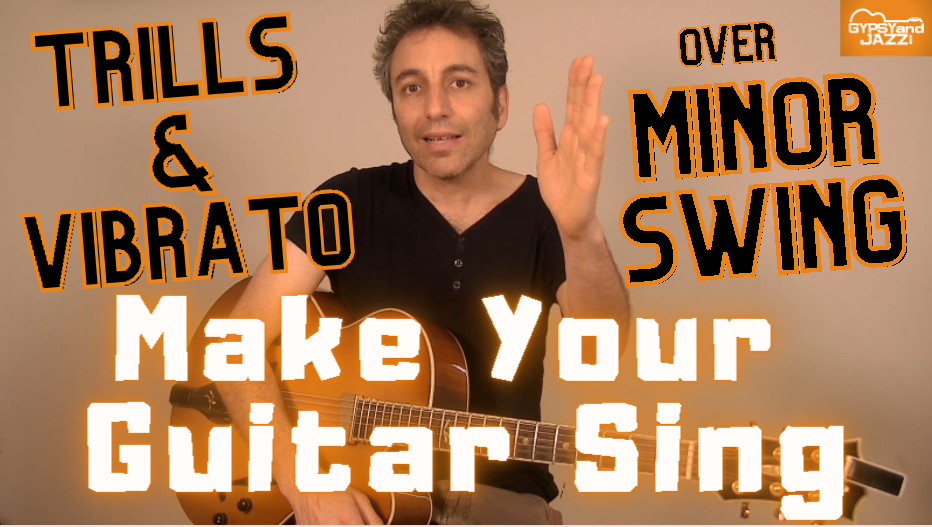
Today I’d like to talk about an aspect of your playing that a lot of jazz improvisers overlook – your sound.
Whether you’re playing jazz guitar or gypsy jazz guitar, playing the “right” notes or chords is simply not enough in order to play a solo that is exciting and fun to play. When you listen to gypsy jazz guitar giants such as Django Reinhardt, Bireli Lagrene, Stochelo Rosenberg, Angelo Debarre and such, you can hear that besides playing great melodic lines that express the harmony in a very clear way, they have an ability to make their guitar “sing”. They add a vocal quality to it that makes even the simplest melody sound powerful and exciting.
In this blog post I’ll reveal to you what are the two main tools these guitar giants use to gain this exciting effect – proper use of trills and vibrato. Knowing how to facilitate these playing techniques can really help you unleash your personal voice on your guitar and be able to improvise with conviction, even without playing sophisticated or fast jazzy lines.
Watch the video to the end to learn how you can make your guitar “sing” too in your improvised solo over Django Reinhardt’s famous tune Minor Swing.
Two Main Tools Instrumentalists Use To Imitate The Human Voice – Vibrato & Trills
In almost every musical tradition around the world, you can hear the great influence of the human voice and song over the performance of music on musical instruments.
Our voice’s timbre, physicality and natural imperfections caused shakes, slides, jumps and swells that through the years and throughout different traditions were translated into different ornaments, glissandos, bends, dynamics, vibrato and trills.
Today we’re going to focus on the last two – vibrato & trills!
Vibrato
Vibrato is probably the most common and universal embellishment of all. You will hear it in almost every musical tradition while its speed and width will vary depending on which region of the world you’re at.
The kind of vibrato used by Django and in gypsy jazz in general is as you guessed – Gypsy/Romani (or manouche) influenced. It’s pretty quick, but not too wide (meaning not much pitch shifting).
How to play a gypsy jazz vibrato?
- Take your thumb off the neck of the guitar and shake the note swiftly but not too widely
- Create the vibrato motion by shaking your forearm up and down and keeping your fingers loose
- You want to ensure that you’re not causing the pitch to really shift to a different note, just make the note sound a little “wavy”
Trills
Also many of the trills Django used to play are influenced by his Gypsy/Romani musical background. These trills became part of the signature sound of gypsy jazz and they have the power to turn a simple melody into a beautiful and exciting musical phrase.
How to play a gypsy jazz trill?
If we want to play this trill around an ‘A’ note –
1. Play a down-stroke A note and then up-stroke of B to A in a pull-off
2. Play a half-step approach from G# down-stroke to A note up-stroke

To play this trill on an off-beat, just omit the A note and play the same shape –

Exercise #1 – Practice The Shape
Let’s play an exercise that combines both the vibrato and the trill techniques –
Over an A minor chord, play a down-beat trill for the A note and resolve it to another chord tone.
For example: trill over A and then land on the 5th of A minor which is the note E.
Experiment with placing this shape over any down-beat or off-beat of the bar.
Exercise #2 – Apply Over Minor Swing
- Let’s play an exercise that combines both the vibrato and the trill techniques –
Over an A minor chord, play a down-beat trill for the A note and resolve it to another chord tone.
For example: trill over A and then land on the 5th of A minor which is the note E
2. Experiment with placing this shape over any down-beat or off-beat of the bar.
3. Add more notes to connect between the chords after each trill you play
4. Try to build a solo over Minor Swing where you play some trills independently and some trills with connecting notes to the harmony.
DO NOT FORGET!
The most crucial aspect of this exercise is to make your guitar SING! Focus on playing simple but passionate and convincing melodic lines. Your main goal is to sound lyrical and beautiful.
That’s all for today, hope you enjoyed this lesson.
Please feel free to ask your questions or share your thoughts in the comments section below!
Cheers,
Yaakov.

Gianfranco
Yaakow! you are an explosion of secrets, that push to love Gipsy!!
Paul
Amazing amazing. Thank you so much for sharing your talents with us. I’m a beginner in my 70s so I can only proceed slowly. My memory is not great but my ear is still good. ThNk you again.